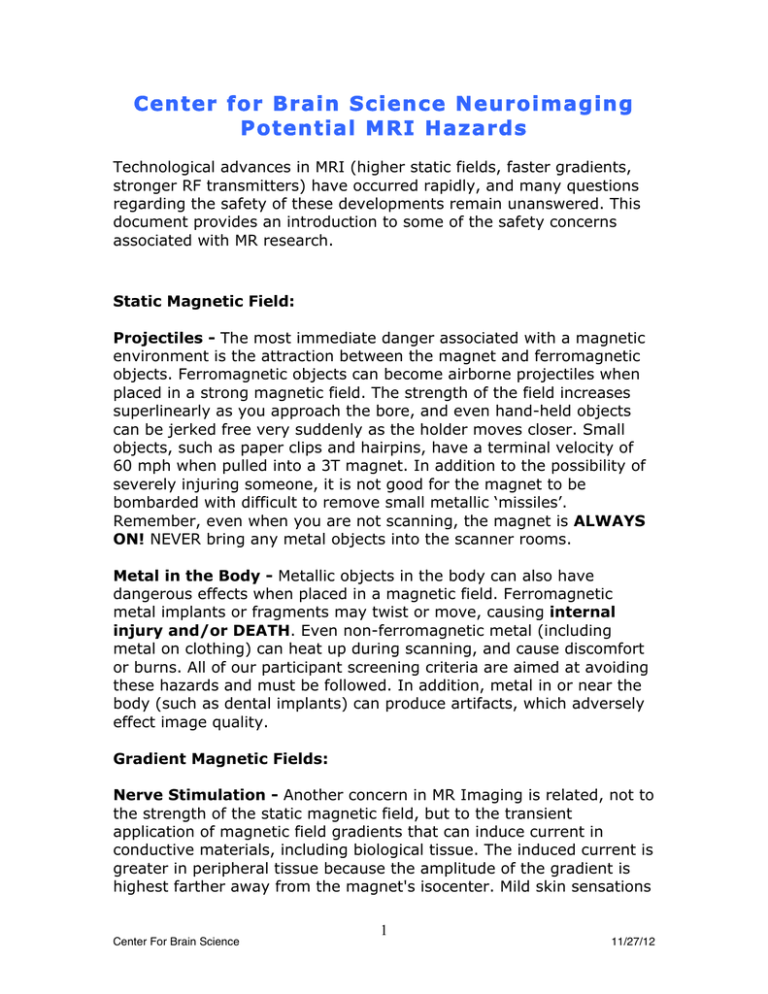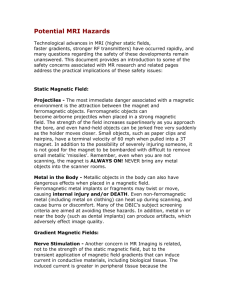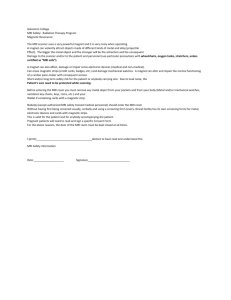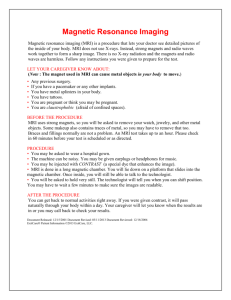CBS Potential MRI Hazards - Center for Brain Science
advertisement

Center for Brain Science Neuroimaging Potential MRI Hazards Technological advances in MRI (higher static fields, faster gradients, stronger RF transmitters) have occurred rapidly, and many questions regarding the safety of these developments remain unanswered. This document provides an introduction to some of the safety concerns associated with MR research. Static Magnetic Field: Projectiles - The most immediate danger associated with a magnetic environment is the attraction between the magnet and ferromagnetic objects. Ferromagnetic objects can become airborne projectiles when placed in a strong magnetic field. The strength of the field increases superlinearly as you approach the bore, and even hand-held objects can be jerked free very suddenly as the holder moves closer. Small objects, such as paper clips and hairpins, have a terminal velocity of 60 mph when pulled into a 3T magnet. In addition to the possibility of severely injuring someone, it is not good for the magnet to be bombarded with difficult to remove small metallic ‘missiles’. Remember, even when you are not scanning, the magnet is ALWAYS ON! NEVER bring any metal objects into the scanner rooms. Metal in the Body - Metallic objects in the body can also have dangerous effects when placed in a magnetic field. Ferromagnetic metal implants or fragments may twist or move, causing internal injury and/or DEATH. Even non-ferromagnetic metal (including metal on clothing) can heat up during scanning, and cause discomfort or burns. All of our participant screening criteria are aimed at avoiding these hazards and must be followed. In addition, metal in or near the body (such as dental implants) can produce artifacts, which adversely effect image quality. Gradient Magnetic Fields: Nerve Stimulation - Another concern in MR Imaging is related, not to the strength of the static magnetic field, but to the transient application of magnetic field gradients that can induce current in conductive materials, including biological tissue. The induced current is greater in peripheral tissue because the amplitude of the gradient is highest farther away from the magnet's isocenter. Mild skin sensations Center For Brain Science 1 11/27/12 and involuntary muscle contractions, which are thought to be the result of direct neural stimulation, have been reported during echo planar imaging (EPI). This can usually be alleviated by repositioning the participant in the scanner. Do not cross arms and legs. Acoustic Noise - Another potentially hazardous effect related to gradient magnetic fields is the acoustic noise produced as current is passed through the gradient coils during image acquisition. For anatomical imaging, the noise is mostly of low frequency and has a "buzzing or hammering" sound; for EPI, the noise can be of very high frequency (600-1400 Hz) and sounds like a loud "pinging" noise. Generally, the higher gradients used with higher magnetic fields along with EPI produce more intense noise. Prolonged exposure to this noise will damage the unprotected ear. Therefore, all participants MUST wear hearing protection in the form of earplugs and/or headphones, during scanning (both are recommended for 3T). ***NOTE*** It is the responsibility of the investigator to see that the participant wears hearing protection. Radiofrequency (RF): Tissue Heating - An RF pulse (a short burst of an electromagnetic wave originating from the RF coils) is used in MRI to "excite" protons by an exchange of energy. This absorption of RF energy can potentially cause heating of the tissue. Absorption of RF power by the tissue is described in terms of Specific Absorption Rate (SAR), which is expressed in Watts/kg. (In the US, the recommended SAR level for head imaging is 3.2 Watts/kg.) SAR in MRI is a function of many variables including pulse sequence and coil parameters and the subject’s weight. However, the actual increase in tissue temperature caused by exposure to RF radiation is dependent on the persons’ thermoregulatory system. This is why when using the 3T magnet we do not allow the use of blankets or restrictive (such as large sweaters) clothing. The participant must be able to dissipate heat properly. Electrical Burns - RF fields can cause burns by producing electrical currents in conductive loops. When using equipment such as surface coils, EEG leads, and response cables the investigator must be extremely careful not to allow the wire or cable to form a conductive loop with itself or with the participant. Center For Brain Science 2 11/27/12 Other Concerns: Pregnancy - There are no known adverse effects of MRI on developing fetuses. Most early studies on pregnant animals were negative for teratogenic effects, and recent studies found no association between working in the MR environment and a number of pregnancy outcome variables*. However, given the scarcity of data on the subject and the high susceptibility of the developing fetus to damage in general, we believe it is not worth the risk for pregnant women to participate as subjects in MR research studies. Most clinical facilities allow pregnant employees to enter the scan room, but not to remain in the room while the RF and gradient fields are applied during image acquisition. Pregnant researchers at the Center will regulate their own exposure to the magnets. *For references see Shellock and Kanal, 1996, Ch. 5 Additional Information: If a participant has any medical implants or devices, you must get clearance from Tammy Moran before performing the MRI. See Participant Screening Documentation. For more information regarding MRI safety, please go to MRIsafety.com Center For Brain Science 3 11/27/12



